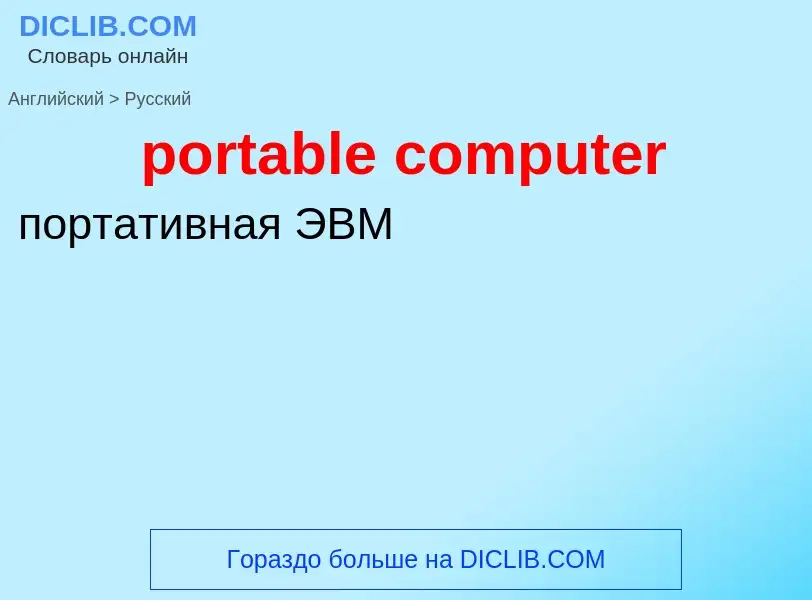Перевод и анализ слов искусственным интеллектом ChatGPT
На этой странице Вы можете получить подробный анализ слова или словосочетания, произведенный с помощью лучшей на сегодняшний день технологии искусственного интеллекта:
- как употребляется слово
- частота употребления
- используется оно чаще в устной или письменной речи
- варианты перевода слова
- примеры употребления (несколько фраз с переводом)
- этимология
portable computer - перевод на русский
общая лексика
портативный компьютер
достаточно легкие и маленькие компьютеры, которые можно переносить в руках, а также работающие без подключения к обычной сети электропитания. К ним относят, в частности, ноутбуки, субноутбуки и т.д.
антоним
Смотрите также
общая лексика
Program Segment Prefix
префикс сегмента программы
общая лексика
ручной
['hændheld]
общая лексика
ручной, переносной, карманный, портативный, миниатюрный
прилагательное
общая лексика
ручной
переносной
портативный
переносной, портативный
общая лексика
карманный ["ручной"] ПК, КПК
класс компьютеров, имеющих размеры с записную книжку, которые можно держать в одной руке и помещать в карман куртки
Смотрите также
Определение
Википедия

A portable computer is a computer designed to be easily moved from one place to another, as opposed to those designed to remain stationary at a single location such as desktops and workstations. These computers usually include a display and keyboard that are directly connected to the main case, all sharing a single power plug together, much like later desktop computers called all-in-ones (AIO) that integrate the system's internal components into the same case as the display. In modern usage, a portable computer usually refers to a very light and compact personal computer such as a laptop, miniature or pocket-sized computer, while touchscreen-based handheld ("palmtop") devices such as tablet, phablet and smartphone are called mobile devices instead.
The first commercially sold portable computer might be the 20-pound (9.1 kg) MCM/70, released 1974. The next major portables were the 50-pound (23 kg) IBM 5100 (1975), Osborne's 24-pound (11 kg) CP/M-based Osborne 1 (1981) and Compaq's 28-pound (13 kg), advertised as 100% IBM PC compatible Compaq Portable (1983). These luggable computers still required a continuous connection to an external power source; this limitation was later overcome by the laptop computers. Laptops were followed by lighter models such as netbooks, so that in the 2000s mobile devices and by 2007 smartphones made the term "portable" rather meaningless. The 2010s introduced wearable computers such as smartwatches.
Portable computers, by their nature, are generally microcomputers. Larger portable computers were commonly known as 'Lunchbox' or 'Luggable' computers. They are also called 'Portable Workstations' or 'Portable PCs'. In Japan they were often called 'Bentocom'. (ベントコン, Bentokon) from "bento".
Portable computers, more narrowly defined, are distinct from desktop replacement computers in that they usually were constructed from full-specification desktop components, and often do not incorporate features associated with laptops or mobile devices. A portable computer in this usage, versus a laptop or other mobile computing device, have a standard motherboard or backplane providing plug-in slots for add-in cards. This allows mission specific cards such as test, A/D, or communication protocol (IEEE-488, 1553) to be installed. Portable computers also provide for more disk storage by using standard disk drives and provide for multiple drives.


![Portal]] laptop in September 1980 at the SICOB show in PARIS Portal]] laptop in September 1980 at the SICOB show in PARIS](https://commons.wikimedia.org/wiki/Special:FilePath/Micro ordinateur portable le PORTAL de R2E CCMC.jpg?width=200)


![YP<sub>B</sub>P<sub>R</sub>]]) video YP<sub>B</sub>P<sub>R</sub>]]) video](https://commons.wikimedia.org/wiki/Special:FilePath/PSP-Component-Cables.jpg?width=200)

![PSP running a [["Hello, World!" program]] PSP running a [["Hello, World!" program]]](https://commons.wikimedia.org/wiki/Special:FilePath/PSP-Homebrew.jpeg?width=200)
![PSP 3000 navigating through [[Spanish Wikipedia]] PSP 3000 navigating through [[Spanish Wikipedia]]](https://commons.wikimedia.org/wiki/Special:FilePath/PSP 3000 Español.jpg?width=200)




.jpg?width=200)

